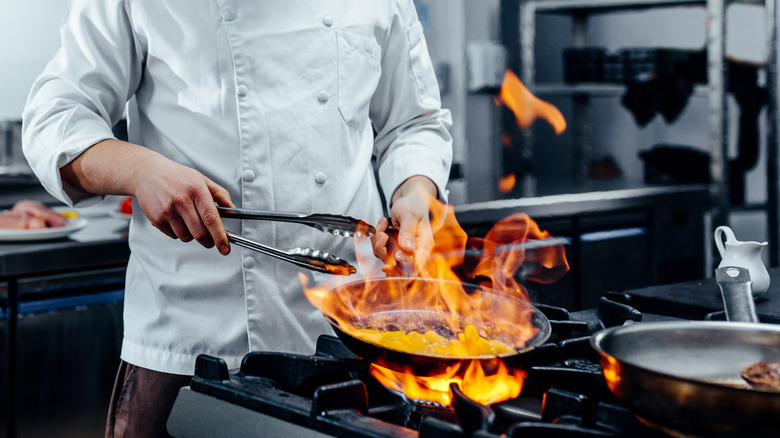The Reason Many Professional Chefs Avoid Using Non-Stick Skillets
Non-stick skillets can be useful from time to time, but they have their downsides, especially in a fast-paced restaurant kitchen. The coating that makes food not stick to the pan is delicate. Scratches from metal utensils can cause it to eventually peel off, and cooking over high heat can damage the surface permanently. Busy professional kitchens need pots and pans that can withstand years of heavy-duty use, meaning durable, uncoated metal items. It's just not practical or cost-effective from a business perspective to buy non-stick pans when that means frequently replacing them as they get damaged.
Those working choices often translate to home use for professional chefs too, although they might prefer a nicer metal brand than the standard restaurant supply. Gordon Ramsay's preference for durable Hexclad is one example — the high-end stainless steel etched pans hold up under high heat and can be used with metal utensils, so they perform well under the same heavy use that working restaurant pans get.
How professional chefs cook without non-stick
Restaurant cookware is usually solid aluminum or stainless steel, although some fine dining kitchens may use durable lined copper pans. The pans are heavyweight enough to hold up to the high heat of commercial stoves, and they have metal handles that won't melt on the range or if popped into the oven. Cleaning these pans is easy with scrubbing pads, which is important, as they can be quickly returned to the cook for another turn on the stove.
The chef's trick for cooking on plain metal pan surfaces is to first heat the empty pan over medium heat for a few minutes. Heating the pan helps close the microscopic pores in the metal that can trap food and make it stick. Even oil can seep in these pores, and when it overheats there, that causes a sticky cooking surface. When a drop of water dances across the pan, it's hot enough to add oil. After a quick swirl to coat the pan, food can then be seared or sauteed without worrying about sticking. A good, hot pan allows for proper browning of foods, and the golden pan bottom can be deglazed to add flavor to a pan sauce. That's hard to do in non-stick since brown bits don't adhere to the pan long enough to brown, and that makes metal pans even more useful, at home or in a professional kitchen.

